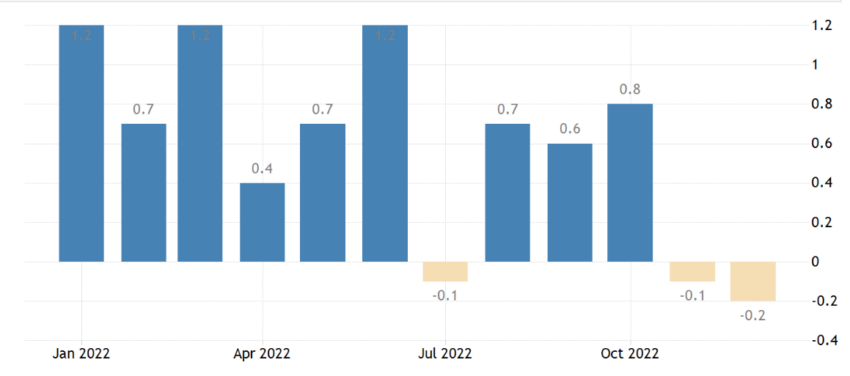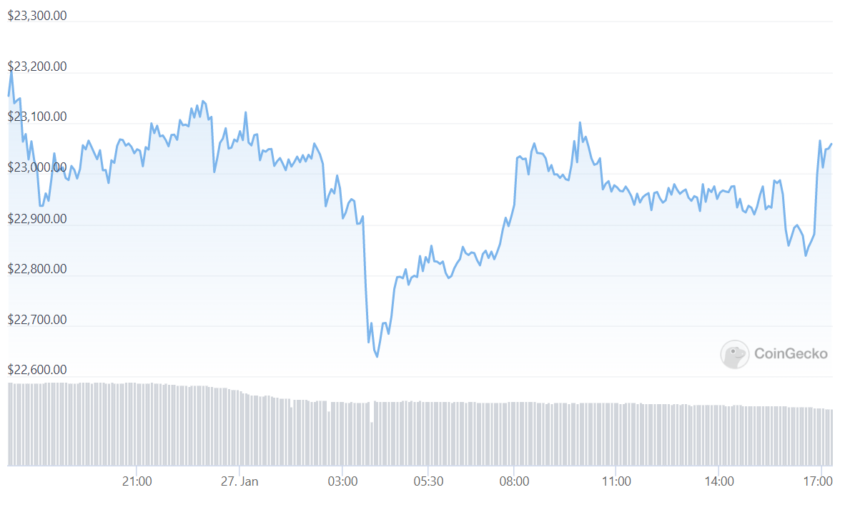Bitcoin held onto gains driven by the recent bullish trading in crypto derivatives, as consumer spending fell 0.2% in December 2022.
The U.S. Personal Consumption Expenditure (PCE), a measure of consumer spending, was down 0.2% month-on-month in Dec. 2022, falling below analysts’ expectations of 0.1%.

At the same time, the so-called core PCE, excluding food and energy prices, fell 0.3% month-on-month in Dec. 2022. Year-on-year, the core PCE rose 4.4% in Dec. 2022, down from 4.7% in Nov. 2022. Personal income, which measures how much people earn, rose 0.2%, while personal savings also increased.
Bitcoin 2023 Rally Mostly Unperturbed by Personal Consumption Expenditure
Crypto markets struggled to interpret the data, with Bitcoin rising to almost $23,000 after the data was released before falling back to around $22,850. At press time, the world’s largest crypto by market capitalization had stabilized around $23,040. Ethereum also saw a brief rally to just under $1,580, before it declined to around $1,568. It eventually stabilized higher at $1,584.
Bitcoin has mostly held onto gains of 40% since the start of 2023, fueled partly by bullish trading in Bitcoin options, according to Pierino Ursone of the crypto derivatives exchange Deribit.

Following the release of the PCE numbers, equity markets remained mostly flat, having already priced in the numbers after the release of the U.S. Gross Domestic Product on Jan. 26, 2023. The U.S. economy grew 2.9% in the fourth quarter of 2022, down 0.3% from the third quarter.
The PCE Price Index, the Federal Reserve’s primary inflation gauge, is calculated using consumer spending across various categories. It considers durable goods like appliances, nondurable goods like food, and service categories like financial services and healthcare. Unlike the Consumer Price Index, the PCE can be adjusted to reflect short-term consumer behavior changes, like choosing cheaper alternatives.
On the other hand, the Consumer Price Index offers a more granular picture through its evaluation of the prices of everyday items, like cereal and fresh produce.
Fed Will Have ‘Asymmetric’ Hawkish Bias at Next Meeting, Economist Says
While month-on-month Consumer Price Index and Labor numbers point to an economic slowdown, higher year-on-year numbers mean that “The Fed is going to have an asymmetric bias toward hawkishness,” Credit Suisse Chief Economist Ray Ferris told Bloomberg after the PCE numbers were released.
Experts predict that the Fed will hike interest rates by 25 basis points at its meeting next week. This hike would follow four 0.75% increases in 2022 after a period of almost zero interest rates.
However, due to the lag in economic response and consensus that growth has reached a local peak and will get weaker going forward, the Federal Reserve will likely have to carefully consider the aggression of its next rate hike to ensure it doesn’t cripple a flagging economy.
For Be[In]Crypto’s latest Bitcoin (BTC) analysis, click here.
Disclaimer
In adherence to the Trust Project guidelines, BeInCrypto is committed to unbiased, transparent reporting. This news article aims to provide accurate, timely information. However, readers are advised to verify facts independently and consult with a professional before making any decisions based on this content. Please note that our Terms and Conditions, Privacy Policy, and Disclaimers have been updated.


